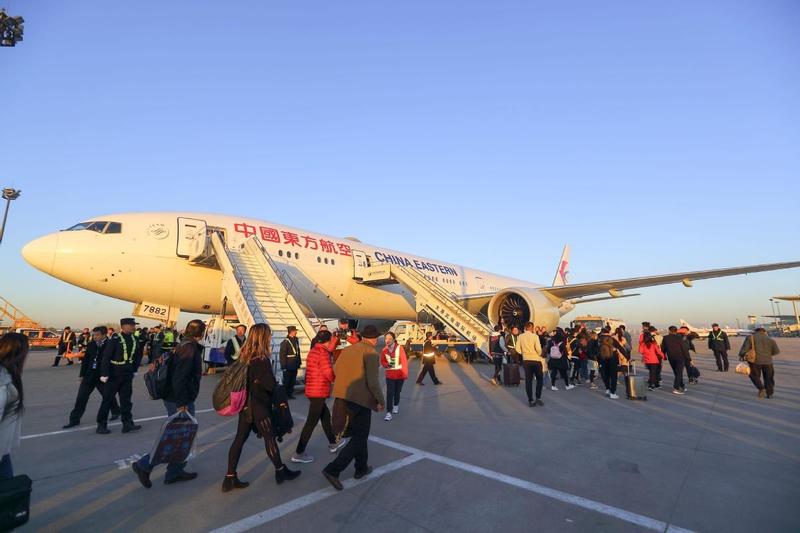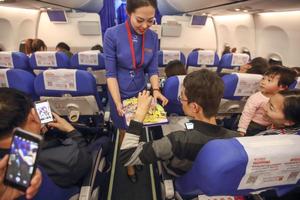Airline firms come out with innovative products to increase demand as pandemic slams aviation sector
 Passengers wait to board a China Eastern Airlines aircraft at the Taiyuan airport in Shanxi province. (PHOTO / CHINA NEWS SERVICE)
Passengers wait to board a China Eastern Airlines aircraft at the Taiyuan airport in Shanxi province. (PHOTO / CHINA NEWS SERVICE)
Chinese airlines are innovating their products to boost demand as the novel coronavirus pandemic slams the aviation sector, leading to low occupancy rates and reduced flights, said experts.
China Eastern Airlines took the lead by launching its "unlimited weekend flights" product on June 18 in hopes of encouraging travel across the nation.
The unprecedented package is priced at 3,322 yuan (US$474), and allows economy-class passengers to fly at any time to any destination on the Chinese mainland during weekends until the end of the year, with multiple weekend getaways allowed.
After designing products in accordance with market demand, airlines can gain precious experience that enables them to grow better and develop further
Yu Zhanfu, partner and vice-president for China at consultancy Roland Berger
"COVID-19 has severely impacted global aviation at a level that virtually resets the sector. In the past few months, we have seen a huge reduction in travel budgets, falling demand for personal travel out of safety and job worries as well as business trips being largely replaced by videoconferencing and other remote methodologies," said Yu Zhanfu, partner and vice-president for China at consultancy Roland Berger.
This latest marketing activity should be viewed as being successful in terms of its social influence, regardless of its actual profitability, said Xiong Wei, an aviation industry analyst at Carnoc.com, one of China's biggest civil aviation websites.
As the first carrier to launch a ticket package in Chinese aviation, China Eastern has received very positive market feedback. On the weekend of June 27 and June 28, more than 65,000 tickets were redeemed, and nearly 90,000 trips were made using the promotion during the weekend of July 4 and July 5, Huanqiu.com reported.
The carrier's move has significantly lifted the airline's passenger load factor, particularly in major routes linking key destinations. The passenger load factor of flights from Shanghai Hongqiao International Airport to Shenzhen, Guangdong province, rose from 37.6 percent and 51.2 percent on June 20 and June 21, to 69.25 percent and 81.62 percent on June 27 and June 28, and further increased to 76.4 percent and 88.57 percent on July 4 and July 5, according to AirSavvi, a Chinese aviation data and solutions services provider.
 An air hostess gives candies to passengers as New Year Eve gifts during a China Eastern Airlines flight from Haikou, capital of South China's Hainan province, to Taiyuan, capital of North China's Shanxi province, on Dec 31, 2019. (PHOTO / CHINA NEWS SERVICE)
An air hostess gives candies to passengers as New Year Eve gifts during a China Eastern Airlines flight from Haikou, capital of South China's Hainan province, to Taiyuan, capital of North China's Shanxi province, on Dec 31, 2019. (PHOTO / CHINA NEWS SERVICE)
More Chinese carriers are following suit. On June 23, China Express Airlines, the nation's first specialized regional flight operator, pitched 1,000 sets of flight combos priced at 2,999 yuan for its new clients, doctors and nurses, allowing them to fly with it any time between June 28 and Oct 24 (excluding the period from Sept 28 to Oct 10).
However, China Express Airlines saw less significant improvement in its occupancy rate, as most of its routes had little change when measured by seats/kilometers.
"China Eastern has more passengers with greater traveling demand between major Chinese cities that was temporarily pent up by the epidemic, but regional flight operators can do little because of their narrower client base and less popular destinations," Yu said.
The average passenger load factor for China Eastern stood at 68.4 percent in June, and that of China Express Airlines was 65.2 percent during the same period, AirSavvi said.
Hainan Airlines rolled out its own version of ticket promotions on July 1, allowing passengers to fly freely with 12 airlines under Hainan Airlines Group to and from Hainan province.
"Differing from China Eastern and China Express, Hainan Airlines' special offerings are tailored for promoting Hainan as a free trade port and its duty-free policies," said Qi Qi, an associate professor at Guangzhou Civil Aviation College.
China unveiled a major plan on June 1 with the aim of building Hainan into a globally influential high-level free trade port by the middle of the century. And on June 29, Chinese authorities announced that they will increase Hainan's annual duty-free shopping quota to 100,000 yuan per person each year from the current 30,000 yuan for travelers, the Xinhua News Agency reported.
Budget carrier Spring Airlines has also designed ticket packages, and plans to launch them today. According to the Shanghai-based carrier, passengers purchasing the packages can book from among its more than 170 flights to reach any destination across China, including Hong Kong, Macao and Taiwan, until the end of the year.
"Although the ticket sales tactic is not new globally, it's good that carriers are providing more innovative ticket products," Yu said.
"After designing products in accordance with market demand, airlines can gain precious experience that enables them to grow better and develop further," he added.


